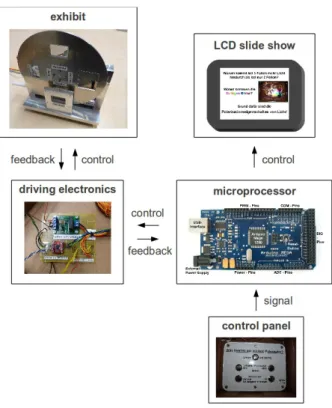A Stand-Alone Interactive Physics Showcase
Daniel Pfaff,
1Anja Hagelgans,
1Klaus Bretzer,
2and Matthias Weidemüller
11
Physics Institute of the University of Heidelberg, Philosophenweg 12, 69120 Heidelberg, Germany
2
Gymnasium Bammental,
Herbert-Echner-Platz 2, 69245 Bammental, Germany Email: weidemueller@uni-heidelberg.deA showcase with interactive exhibits of basic physical experiments constitutes a
complementary method for teaching physics and making students become interested in physical phenomena. Our interactive physics showcase, shown in Fig. 1, intends to stimulate interest for science by letting the students directly experience surprising phenomena and by providing a first approach to the physical concepts explaining them. In letting the students interactively perform experiments under optimum safety conditions and good protection against vandalism, our approach is complementary to interactive simulations as, e.g., offered by the Physics Education Technology project [1].
The didactic concept behind the showcase consists of three key elements. First, students directly experience an effect by performing an experiment in the showcase, and, surprised by their observations, become curious to find an explanation for the observed phenomenon.
Second, a first guidance to approach the concepts behind the effect is provided by digital LCD photo frames with an introductory slide show (see Fig.
1). The transparencies shown in these frames deliver a basic introduction of the physical
background related to the respective experiments without giving a full explanation. Third, keywords provided in the slide show should stimulate further independent studies and discussions, either with classmates, teachers, books or internet
resources.
Besides independent experimenting of the students, the showcase and its exhibits may easily be integrated in the syllabus of a physics class at highschool. The showcase specifically addresses the age group between 12 and 16 years, as this age group is decisive for stimulating later interest in science, in particular physics.
Therefore, the four major areas of physics contained in the syllabus of this age group, namely mechanics, electromagnetism, optics and thermodynamics, are represented in the
showcase. Our first experience with the student's reception of the showcase, which has been placed in the main entrance hall of a German secondary school, is very positive supporting the three-step concept outlined above.
Fig. 1: Interactive physics showcase with six exhibits placed in the entrance hall of the Gymnasium
Bammental, a German secondary school.
The interactive experiments constitute the
fundamental element of the concept. They should show a fundamental, yet surprising effect and cover a large variety of physics areas. Until now, ten exhibits have been designed and constructed, which are, in increasing complexity:
• Optics: A glass cylinder refracting a sentence, which partly consists of symmetric letters creating the impression that only half of the sentence is actually refracted by the glass.
• Electromagnetism: Measurement of the conductance of the human body.
• Mechanics: Two pendula coupled by a spring [2].
• Optics: Additive mixing of colors (red, blue, green) with adjustable intensity [3].
1
• Mechanics: Centripetal and centrifugal forces demonstrated by a rotor with two equal spheres with different mass
attached to it, showing the equivalence of heavy and intertial mass.
• Optics: Poisson's Spot [4].
• Electromagnetism: Inductively coupled electronic oscillators to show wireless energy transfer.
• Optics: Crossed polarizers and optical activity [5].
• Mechanics: Bead rail to demonstrate the Brachistochrone [6].
• Thermodynamics: Leslie’s Cube and Kirchhoff's law of thermal radiation [7].
The stand-alone showcase, made of safety glass, contains six exhibits, placed on three shelves within the showcase. The exhibits can be manipulated from outside the showcase via external control panels, three on each of the two opposing long sides of the showcase. In this way, the students can independently perform the experiment by themselves, e.g. adjusting the intensity of the color mixing exhibit, or start the bead race in the Brachistochrone exhibit. The slide shows on the six LCD photo frames,
positioned at the shelves on the short sides of the showcase, are started by pushing a button at the control panel.
The control circuits of the showcase are schematically depicted in Fig. 2. All processes within the showcase are driven by a
microprocessor (Ardugno Mega 1280),
programmed in C. It starts, stops and controls the electronic circuits of the various exhibit hardware, and starts and controls the duration of the slide shows (consisting of Powerpoint or JPG slides) on the LCD panels. The basic concept can be
explained on the example of the crossed polarizer exhibit, as shown in Fig. 2. The exhibit allows to introduce different transparent materials,
exhibiting optical activity (tape, a polarizer under 45 degrees, plastic window under stress) between two crossed polarizers by turning a wheel, on which the materials are attached. The rotation of the wheel and the light bulb behind the crossed polarizers are driven by standard electronic circuits. The microprocessor controls the electronic circuits based on the signals received from the control panel, assuring, e.g. 90 degrees rotation clock- or counterclock-wise. It also allows to include additional features, as, e.g., turning off the light bulb after a defined time. In addition to controlling the driving electronics, the
microprocessor defines the start and exposure length of each slide of the slide show which is saved on the digital LCD photo display.
Fig. 2: Schematic of the electronic control circuitry of the interactive physics showcase with the example of
the crossed polarizer exhibit.
This approach allows for a maximum of flexibility and a minimum amount of wiring inside the showcase. Exhibits can easily be exchanged and new exhibits can be integrated by simply
reconfiguring the microprocessor. Care has been taken to keep costs of the exhibits and the showcase as a whole at a low level in order to allow other schools to copy the concept. Typical costs are below $ 100 for each exhibit (not including manufacturing costs), around $ 1000 for the showcase made of security glas, and roughly
$ 1000 for the electronic infrastructure and periphery.
Motivated by the positive reception of the showcase by the students, we are currently developing concepts for additional exhibits to be included in the showcase, e.g. demonstrating Lenz's law with friction induced by eddy currents [8] and showing thermal effects of radiation using the Crooke's radiometer [9].
For schools interested to build an interactive physics showcase, additional material, technical drawings etc. are available upon request from
weidemueller@uni-heidelberg.de .We thank the mechanical and electronic workshops of the Physics Institute of the
University of Heidelberg for their endless support, and Dr. Shannon Whitlock for useful comments on the manuscript. This work was financially supported by the “Freundeskreis des
2
Gymnasiums Bammental e.V.” and the Physics Institute of the University of Heidelberg.
References
[1] http://phet.colorado.edu; see also Katherine Perkins, Wendy Adams, Michael Dubson, Noah Finkelstein, Sam Reid, Carl Wieman, Ron LeMaster, Phys. Tech. 44, 18 (2006).
[2] Joseph Priest and James Poth, Phys. Teach.
20, 80 (1982).
[3] William A. Butler, A. Douglas Davis, and Charles E. Miller, Phys. Teach. 17, 43 (1979).
[4] Matthew Hoover, Michael Everhart, and Jose D'Arruda, Phys. Teach. 48, 135 (2010), and references therein.
[5] Don Easton, Phys. Teach. 39, 231 (2001).
[6] R. D. Edge, Phys. Teach. 23, 372 (1985).
[7] D. Pfaff and M. Weidemüller, submitted to Physics Teacher.
[8] Carlos Saraiva, Phys. Teach. 44, 182 (2006).
[9] Arthur E. Woodruff, Phys. Teach. 6, 358 (1968).
3

